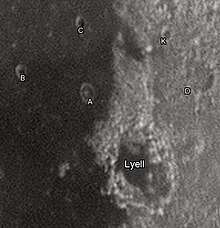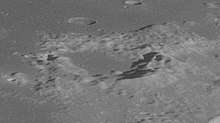Lyell (lunar crater)
Lyell is a lunar impact crater that lies along the eastern edge of the Mare Tranquillitatis, at the northern arm of the bay designated Sinus Concordiae. It was named after Scottish geologist Charles Lyell.[1] To the north along the edge of the lunar mare is the crater Franz. The region of terrain to the east of Lyell is named Palus Somni.
 Apollo 17 Mapping Camera image | |
| Coordinates | 13.6°N 40.6°E |
|---|---|
| Diameter | 32 km |
| Depth | 1.0 km |
| Colongitude | 320° at sunrise |
| Eponym | Charles Lyell |
The outer rim of this crater is an irregular series of ridges in a roughly circular formation. There are multiple gaps through this rim, connected the interior to the mare in the west. The wall is at its thickest along the eastern side of the crater.
The interior floor has been resurfaced by lava, leaving a level, featureless surface that has no markings or impacts of note. The central region of the inner floor has a relatively low albedo compared to the surrounding terrain, giving it a dark appearance that matches the nearby mare.
Satellite craters

By convention these features are identified on lunar maps by placing the letter on the side of the crater midpoint that is closest to Lyell.

| Lyell | Latitude | Longitude | Diameter |
|---|---|---|---|
| A | 14.3° N | 39.6° E | 7 km |
| B | 14.4° N | 38.4° E | 5 km |
| C | 15.2° N | 39.4° E | 5 km |
| D | 14.7° N | 41.5° E | 18 km |
| K | 15.3° N | 40.9° E | 5 km |
References
- "Lyell (lunar crater)". Gazetteer of Planetary Nomenclature. USGS Astrogeology Research Program.
- Andersson, L. E.; Whitaker, E. A. (1982). NASA Catalogue of Lunar Nomenclature. NASA RP-1097.CS1 maint: ref=harv (link)
- Bussey, B.; Spudis, P. (2004). The Clementine Atlas of the Moon. New York: Cambridge University Press. ISBN 978-0-521-81528-4.CS1 maint: ref=harv (link)
- Cocks, Elijah E.; Cocks, Josiah C. (1995). Who's Who on the Moon: A Biographical Dictionary of Lunar Nomenclature. Tudor Publishers. ISBN 978-0-936389-27-1.CS1 maint: ref=harv (link)
- McDowell, Jonathan (July 15, 2007). "Lunar Nomenclature". Jonathan's Space Report. Retrieved 2007-10-24.CS1 maint: ref=harv (link)
- Menzel, D. H.; Minnaert, M.; Levin, B.; Dollfus, A.; Bell, B. (1971). "Report on Lunar Nomenclature by the Working Group of Commission 17 of the IAU". Space Science Reviews. 12 (2): 136–186. Bibcode:1971SSRv...12..136M. doi:10.1007/BF00171763.CS1 maint: ref=harv (link)
- Moore, Patrick (2001). On the Moon. Sterling Publishing Co. ISBN 978-0-304-35469-6.CS1 maint: ref=harv (link)
- Price, Fred W. (1988). The Moon Observer's Handbook. Cambridge University Press. ISBN 978-0-521-33500-3.CS1 maint: ref=harv (link)
- Rükl, Antonín (1990). Atlas of the Moon. Kalmbach Books. ISBN 978-0-913135-17-4.CS1 maint: ref=harv (link)
- Webb, Rev. T. W. (1962). Celestial Objects for Common Telescopes (6th revised ed.). Dover. ISBN 978-0-486-20917-3.CS1 maint: ref=harv (link)
- Whitaker, Ewen A. (1999). Mapping and Naming the Moon. Cambridge University Press. ISBN 978-0-521-62248-6.CS1 maint: ref=harv (link)
- Wlasuk, Peter T. (2000). Observing the Moon. Springer. ISBN 978-1-85233-193-1.CS1 maint: ref=harv (link)
External links
| Wikimedia Commons has media related to Lyell (crater). |
- LTO-61B1 Lyell — L&PI topographic map